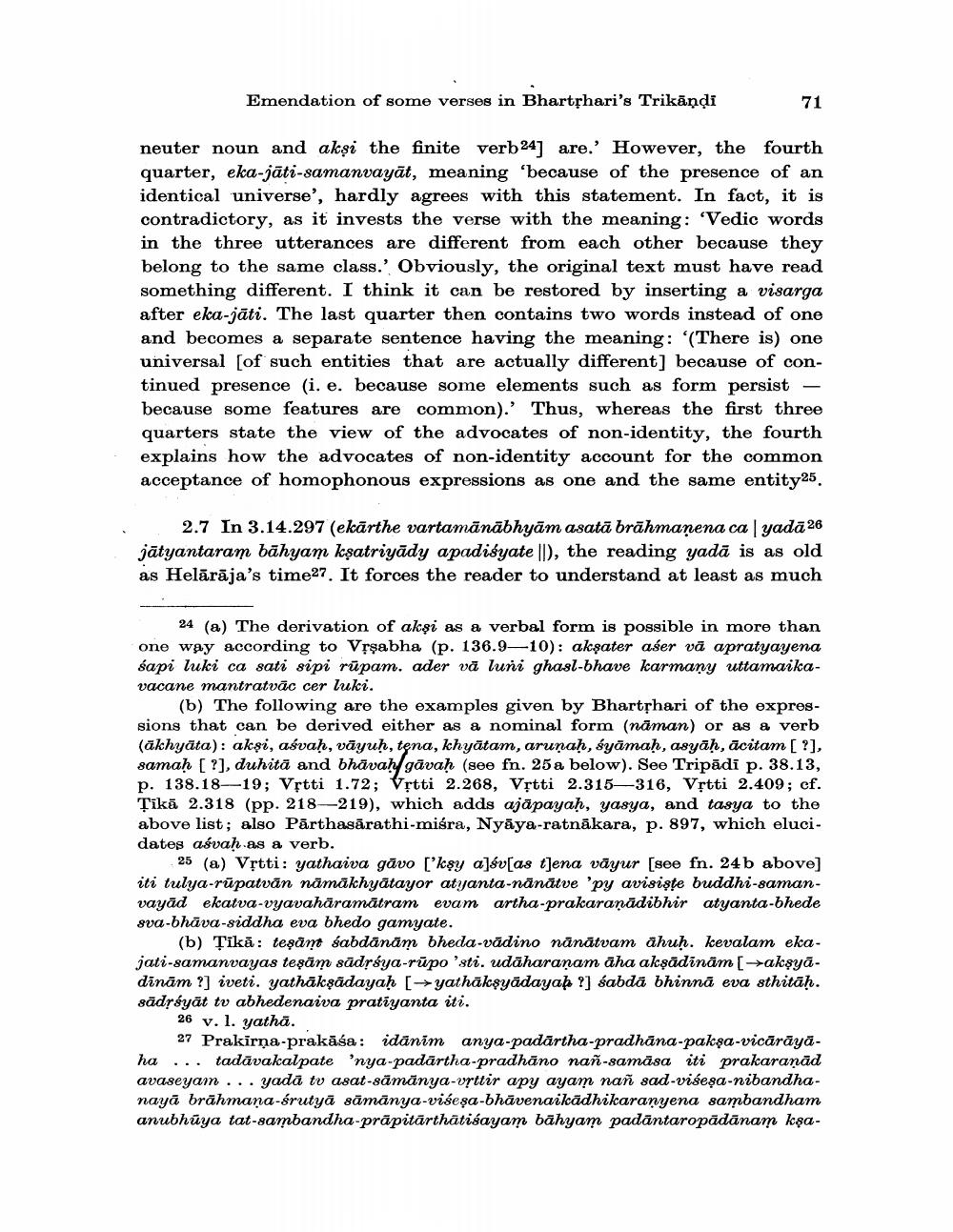Book Title: Emendation Of Some Verses In Bhrtharis Trikandi Author(s): Ashok Aklujkar Publisher: Ashok Aklujkar View full book textPage 9
________________ Emendation of some verses in Bhartṛhari's Trikāṇḍi 71 neuter noun and aksi the finite verb 24] are.' However, the fourth quarter, eka-jāti-samanvayāt, meaning 'because of the presence of an identical universe', hardly agrees with this statement. In fact, it is contradictory, as it invests the verse with the meaning: 'Vedic words in the three utterances are different from each other because they belong to the same class.' Obviously, the original text must have read something different. I think it can be restored by inserting a visarga after eka-jāti. The last quarter then contains two words instead of one and becomes a separate sentence having the meaning: (There is) one universal [of such entities that are actually different] because of continued presence (i. e. because some elements such as form persist because some features are common).' Thus, whereas the first three quarters state the view of the advocates of non-identity, the fourth explains how the advocates of non-identity account for the common acceptance of homophonous expressions as one and the same entity25. 2.7 In 3.14.297 (ekārthe vartamānābhyām asatā brāhmaṇena ca | yadā 26 jatyantaram bähyam kṣatriyādy apadiéyate ||), the reading yada is as old as Helārāja's time27. It forces the reader to understand at least as much 24 (a) The derivation of aksi as a verbal form is possible in more than one way according to Vṛsabha (p. 136.9-10): akşater aśer vā apratyayena sapi luki ca sati sipi rūpam. ader vă luni ghasl-bhave karmany uttamaikavacane mantratvac cer luki. (b) The following are the examples given by Bhartṛhari of the expressions that can be derived either as a nominal form (naman) or as a verb (akhyāta): aksi, aśvaḥ, vayuḥ, tena, khyātam, aruṇaḥ, śyāmaḥ, asyāḥ, ācitam [?], samaḥ [?], duhitā and bhāvaḥ gāvaḥ (see fn. 25a below). See Tripādi p. 38.13, p. 138.18-19; Vrtti 1.72; Vṛtti 2.268, Vṛtti 2.315-316, Vṛtti 2.409; cf. Tikā 2.318 (pp. 218-219), which adds ajapayaḥ, yasya, and tasya to the above list; also Parthasarathi-miśra, Nyaya-ratnākara, p. 897, which elucidates aśvaḥ as a verb. 25 (a) Vṛtti: yathaiva gavo ['ksy a]sv[as t]ena vayur [see fn. 24b above] iti tulya-rūpatvān nāmākhyātayor atyanta-nānātve 'py avisiṣṭe buddhi-samanvayad ekatva-vyavahāramātram evam artha-prakaraṇādibhir atyanta-bhede sva-bhava-siddha eva bhedo gamyate. ha (b) Tikā: teṣām sabdanām bheda-vādino nānātvam āhuḥ. kevalam ekajati-samanvayas teṣām sādṛśya-rupo 'sti. udaharanam aha akṣādinām [→akṣyādīnām?] iveti. yathākṣādayaḥ [→yathākṣyādayaḥ ?] śabdā bhinnā eva sthitāḥ. sādṛśyat tv abhedenaiva pratiyanta iti. 26 v. 1. yatha. 27 Prakirna-prakāsa: idänim anya padartha-pradhana-paksa-vicārāyātadavakalpate 'nya-padartha-pradhano nañ-samasa iti prakaraṇād avaseyam... yadā tv asat-sāmanya-vṛttir apy ayam nañ sad-viseṣa-nibandhanayā brāhmaṇa-śrutyā sāmānya-viścșa-bhāvenaikadhikaranyena sambandham anubhaya tat-sambandha-präpitärthātikayam bāhyam padāntaropādānam kṇaPage Navigation
1 ... 7 8 9 10 11 12
